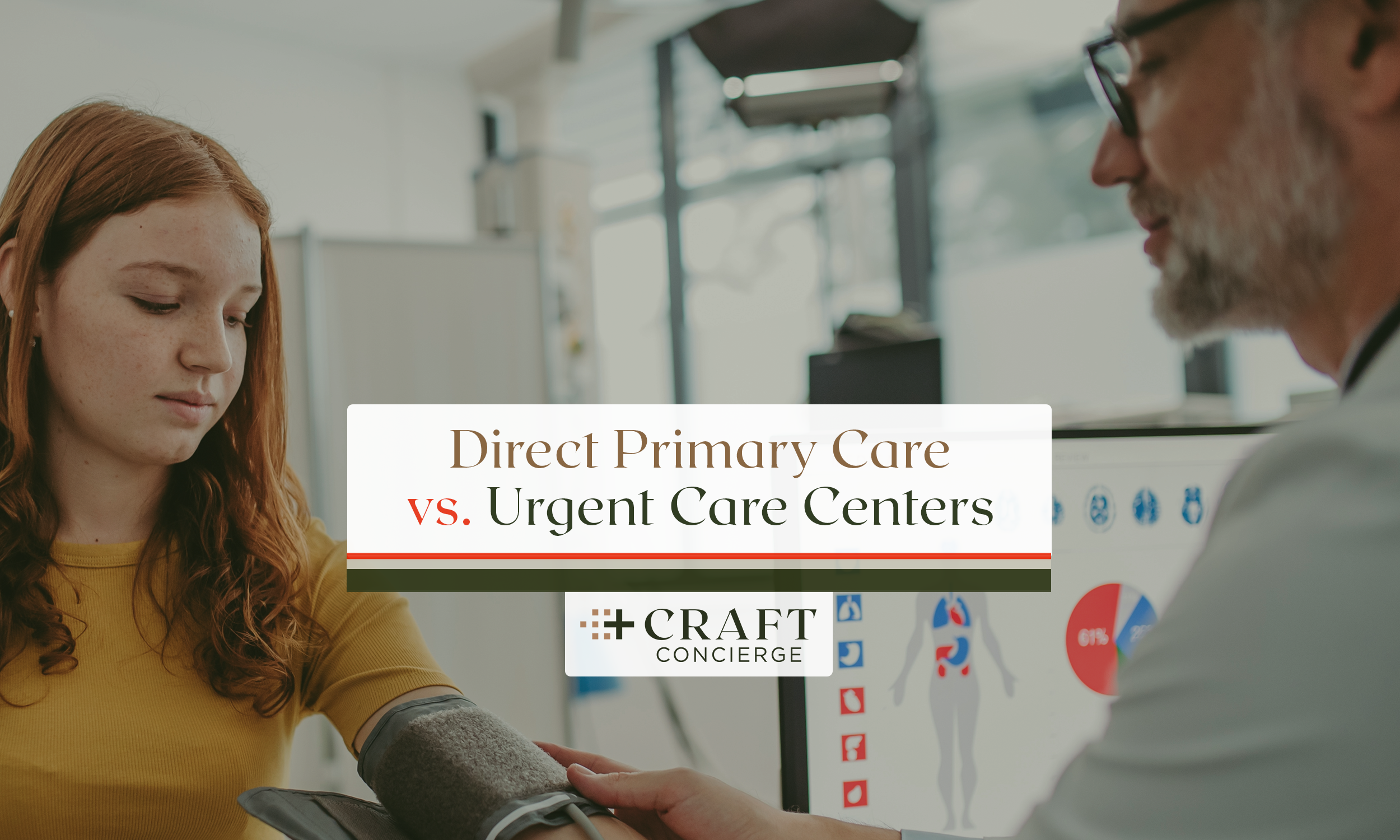We’ve all been there—you’re feeling under the weather, but it’s clearly not an emergency. Your regular doctor can’t see you for days, and the thought of sitting in an emergency room for hours (and paying those bills) makes you feel even worse.
So where do you turn? Two options that often come to mind are Direct Primary Care (DPC) and urgent care centers. While both offer more accessible care than traditional healthcare routes, they serve very different purposes and work in completely different ways.
Understanding the difference between these two options can save you time, money, and a lot of frustration when you need care most. Let’s explore how each one works and when each might be the right choice for you and your family.
What is Direct Primary Care and How Does It Work?
Think of Direct Primary Care as healthcare the way it was meant to be—simple, personal, and focused entirely on your needs. With DPC, you pay a straightforward monthly membership fee for comprehensive primary care services, completely bypassing the insurance maze that makes healthcare so complicated.
When you remove insurance companies from the equation, something wonderful happens: you get direct access to your healthcare provider without all the bureaucratic barriers.
Here’s what most DPC memberships typically include:
Ongoing support for chronic conditions. If you’re managing diabetes, high blood pressure, asthma, or other long-term health issues, you’ll have a dedicated care team that knows your history and works with you to create personalized care plans that actually fit your life.
Preventive care that prevents problems. Regular check-ups, blood pressure monitoring, cholesterol panels, and cancer screenings aren’t just scheduled when convenient for the system—they’re part of your ongoing care plan.
Same-day or next-day appointments when you need them. Woke up with a fever? Concerned about a persistent cough? You won’t be waiting weeks to be seen.
Virtual consultations that work around your schedule. Can’t make it to the office? Your care team is available via phone or video chat, making healthcare accessible even when life gets busy.
DPC’s entire philosophy centers on accessibility, quality time with your provider, and personalized care that adapts to your needs rather than forcing you to adapt to a broken system.
What Is Urgent Care and What Is It Best For?

Urgent care centers fill an important gap in our healthcare system. These walk-in clinics provide immediate care for those not-quite-emergency situations when you need medical attention but don’t need (or want) to go to the emergency room.
Urgent care excels at treating conditions like minor injuries, flu symptoms, skin infections, sprains, and simple fractures—basically, those unexpected health issues that crop up and need attention sooner rather than later.
Here’s an encouraging statistic: studies show that when an urgent care center opens in a community, emergency room visits in that area drop by 17.2% during the hours the center is open. This demonstrates how urgent care helps people get appropriate care for less serious medical issues, reducing the strain on emergency departments while providing more convenient options for patients.
Direct Primary Care vs. Urgent Care

While both models aim to make healthcare more accessible, they approach care delivery in fundamentally different ways. Here’s how they compare:
| Craft Concierge (DPC) Clinic | Urgent Care Clinic | |
| Accessibility | Scheduled appointments, ideal for ongoing care | Walk-in, ideal for immediate short-term concerns |
| Continuity of Care | Long-term direct relationship with a dedicated provider | One-time/episodic visits, often with different providers each time |
| Cost Model | Flat monthly membership fee with no copayments or surprise bills | Pay-per-visit, usually billed through insurance and with copayments |
| Insurance use | Typically does not accept/bill insurance | Often accepts insurance and bills directly |
| Availability | Office hours with same-day or next-day appointments, plus virtual access when needed | Extended hours including evenings and weekends |
| Best for | Chronic condition management, preventive screenings, and ongoing wellness | Minor injuries, infections, fractures, and urgent but non-life-threatening issues |
Understanding these differences helps you choose the right type of care for your specific situation and health goals.
Why People Prefer Direct Primary Care
For many families, DPC offers something that urgent care or emergency department visits simply can’t provide: consistency, genuine relationships, and care that goes far beyond treating symptoms and managing insurance paperwork.
With DPC, you experience shorter wait times, direct communication with healthcare providers who actually know you, and a healthcare approach that’s tailored specifically to you and your family’s unique needs. This model is particularly valuable for people managing chronic conditions or those who prioritize preventive care and wellness.
The peace of mind that comes from having a healthcare team that knows your medical history, understands your concerns, and is readily accessible can be life-changing for many people.
What DPC Doesn’t Cover

While Direct Primary Care offers relationship-driven, accessible care that many people love, it’s important to understand its limitations before making a decision.
Here are some important considerations to keep in mind:
Emergency and trauma care isn’t included. DPC is designed for outpatient primary care, so you’ll still need other arrangements for hospital-based services or true emergencies.
It’s not a complete replacement for insurance. While DPC covers many primary care services, you may still need insurance coverage for hospital stays, surgeries, specialist care, or certain medications that fall outside your membership benefits.
Understanding these limitations helps you make an informed decision about whether DPC aligns with your healthcare needs and financial situation.
When to Choose Urgent Care Over Direct Primary Care

While Direct Primary Care is excellent for ongoing and preventive care, there are definitely times when urgent care might be your best option, especially for immediate needs outside regular hours or when you’re away from your regular provider.
Consider urgent care when:
- You develop a fever or sore throat after your DPC clinic has closed for the day
- You twist an ankle and need an X-ray or quick examination
- You need rapid testing for work or school requirements, like a flu test or COVID screening
- You’re traveling away from home and can’t reach your regular DPC provider
- You have a minor injury or illness that needs immediate attention but isn’t an emergency
Making the Right Choice with Craft Concierge
At the end of the day, choosing between Direct Primary Care and urgent care centers depends on what you value most in your healthcare experience and what your specific health goals are.
If you’re looking for long-term, relationship-based care that’s both affordable and personalized, Craft Concierge’s DPC model might be exactly what you’ve been searching for. If you need immediate care for a one-time, non-life-threatening illness or injury, urgent care can provide the quick fix you need.
At Craft Concierge, you get unlimited direct access to your provider, personalized care designed around your goals, and no surprise bills—all for a consistent monthly fee that you can budget for with confidence.
Ready to experience healthcare that actually works for you? Explore our membership options today and take the first step toward bringing healthcare back to what it should be: simple, direct, and centered entirely around you and your family’s needs.
Contact us today to learn more about how Craft Concierge can transform your healthcare experience!




